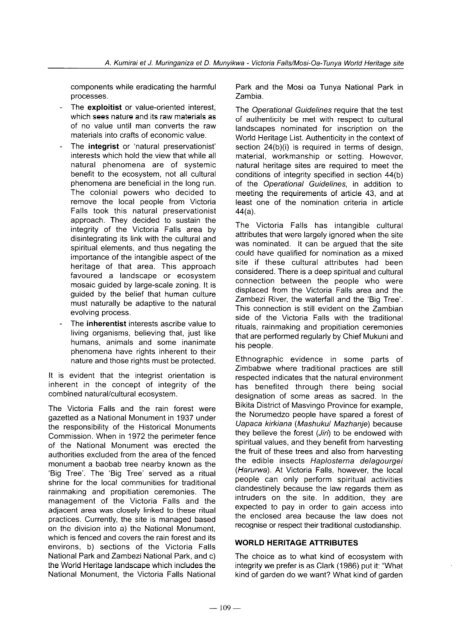Mul - unesdoc - Unesco
Mul - unesdoc - Unesco
Mul - unesdoc - Unesco
Create successful ePaper yourself
Turn your PDF publications into a flip-book with our unique Google optimized e-Paper software.
A. Kumirai et J. Muringaniza et D. Munyikwa - Victoria Falls/Mosi-Oa-Tunya World Heritage site<br />
components while eradicating the harmful<br />
processes.<br />
- The exploitist or value-oriented interest,<br />
which sees nature and its raw materials as<br />
of no value until man converts the raw<br />
materials into crafts of economic value.<br />
- The integrist or ‘natural preservationist’<br />
interests which hold the view that while all<br />
natural phenomena are of systemic<br />
benefit to the ecosystem, not all cultural<br />
phenomena are beneficial in the long run.<br />
The colonial powers who decided to<br />
remove the local people from Victoria<br />
Falls took this natural preservationist<br />
approach. They decided to sustain the<br />
integrity of the Victoria Falls area by<br />
disintegrating its link with the cultural and<br />
spiritual elements, and thus negating the<br />
importance of the intangible aspect of the<br />
heritage of that area. This approach<br />
favoured a landscape or ecosystem<br />
mosaic guided by large-scale zoning. It is<br />
guided by the belief that human culture<br />
must naturally be adaptive to the natural<br />
evolving process.<br />
- The inherentist interests ascribe value to<br />
living organisms, believing that, just like<br />
humans, animals and some inanimate<br />
phenomena have rights inherent to their<br />
nature and those rights must be protected.<br />
It is evident that the integrist orientation is<br />
inherent in the concept of integrity of the<br />
combined natural/cultural ecosystem.<br />
The Victoria Falls and the rain forest were<br />
gazetted as a National Monument in 1937 under<br />
the responsibility of the Historical Monuments<br />
Commission. When in 1972 the perimeter fente<br />
of the National Monument was erected the<br />
authorities excluded from the area of the fenced<br />
monument a baobab tree nearby known as the<br />
‘Big Tree’. The ‘Big Tree’ served as a ritual<br />
shrine for the local communities for traditional<br />
rainmaking and propitiation ceremonies. The<br />
management of the Victoria Falls and the<br />
adjacent area was closely linked to these ritual<br />
practices. Currently, the site is managed based<br />
on the division into a) the National Monument,<br />
which is fenced and covers the rain forest and its<br />
environs, b) sections of the Victoria Falls<br />
National Park and Zambezi National Park, and c)<br />
the World Heritage landscape which includes the<br />
National Monument, the Victoria Falls National<br />
- 109-<br />
Park and the Mosi oa Tunya National Park in<br />
Zambia.<br />
The Operational Guidelines require that the test<br />
of authenticity be met with respect to cultural<br />
landscapes nominated for inscription on the<br />
World Heritage List. Authenticity in the context of<br />
section 24(b)(i) is required in terms of design,<br />
material, workmanship or setting. However,<br />
natural heritage sites are required to meet the<br />
conditions of integrity specified in section 44(b)<br />
of the Operational Guidelines, in addition to<br />
meeting the requirements of article 43, and at<br />
least one of the nomination criteria in article<br />
44(a).<br />
The Victoria Falls has intangible cultural<br />
attributes that were largely ignored when the site<br />
was nominated. It cari be argued that the site<br />
could have qualified for nomination as a mixed<br />
site if these cultural attributes had been<br />
considered. There is a deep spiritual and cultural<br />
connection between the people who were<br />
displaced from the Victoria Falls area and the<br />
Zambezi River, the waterfall and the ‘Big Tree’.<br />
This connection is still evident on the Zambian<br />
side of the Victoria Falls with the traditional<br />
rituals, rainmaking and propitiation ceremonies<br />
that are performed regularly by Chief Mukuni and<br />
his people.<br />
Ethnographie evidence in some parts of<br />
Zimbabwe where traditional practices are still<br />
respected indicates that the natural environment<br />
has benefited through there being social<br />
designation of some areas as sacred. In the<br />
Bikita District of Masvingo Province for example,<br />
the Norumedzo people have spared a forest of<br />
Uapaca kirkiana (Mashukul Mazhanje) because<br />
they believe the forest (Jiro to be endowed with<br />
spiritual values, and they benefit from harvesting<br />
the fruit of these trees and also from harvesting<br />
the edible insects Haplosterna delagourgei<br />
(Harunn/a). At Victoria Falls, however, the local<br />
people cari only perform spiritual activities<br />
clandestinely because the law regards them as<br />
intruders on the site. In addition, they are<br />
expected to pay in order to gain access into<br />
the enclosed area because the law does not<br />
recognise or respect their traditional custodianship.<br />
WORLD HERITAGE ATTRIBUTES<br />
The choice as to what kind of ecosystem with<br />
integrity we prefer is as Clark (1986) put it: “What<br />
kind of garden do we want? What kind of garden

















